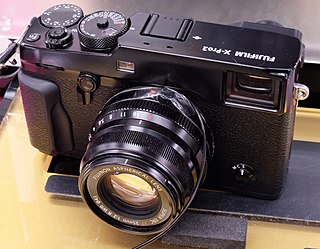 Fujiilm GFX100 II + GF55mm F1.7 R WR | |
| Overview | |
|---|---|
| Maker | Fujifilm |
| Type | Mirrorless Camera |
| Released | September 12, 2023 |
| Intro price | USD 7,499 (body) |
| Lens | |
| Lens mount | Fujifilm G |
| Lens | Interchangeable lens |
| Sensor/medium | |
| Sensor type | CMOS with Bayer filter |
| Sensor size | 43.8 mm × 32.9 mm (medium format) |
| Sensor maker | Sony |
| Maximum resolution | 11648 × 8736 (102 megapixels) |
| Film speed | ISO 80–12800 (standard) ISO 40–102400 (extended) [1] |
| Storage media | SD card (SD, SDHC, SDXC), UHS-I and UHS-II, V90; CFexpress Type B; SSD |
| Focusing | |
| Focus | Intelligent Hybrid TTL contrast detection / Phase detection |
| Focus modes | Single point, Zone, Wide/Tracking; Face/eye detection; Subject detection: Animal, Bird, Automobile, Motorcycle, Bike, Airplane, Train; |
| Focus areas | 117 focus points (13×9 grid): all modes; 425 (25×17 grid): only for manual focus mode or AF mode with single point |
| Focus bracketing | Manual: 0-10 s interval, 1–10 step size, 1–999 frames; Auto: set near and distant focus points |
| Exposure/metering | |
| Exposure bracketing | 2 / 3 / 5 / 7 / 9 frames; min. bracket step 1/3 EV, max. 3 EV |
| Exposure modes | Program, Aperture Priority, Shutter Speed Priority, Manual Exposure |
| Exposure metering | TTL 256-zones metering |
| Metering modes | Multi, Spot, Average, center weighted |
| Flash | |
| Flash | External flash: attached to hot shoe or (by cord) to sync contact |
| Flash exposure compensation | TTL: ±5 EV; Manual: 1/512 tp 1/1 in 1/3 EV steps (only available when an optional shoe-mounted compatible flash / remote unit is attached and activated) |
| Flash synchronization | 1/125 s (both hot shoe and sync contact) |
| Flash bracketing | ±1/3 EV / ±2/3 EV / ±1 EV |
| Compatible flashes | Fujifilm TTL flash / remote units and compatible |
| Shutter | |
| Frame rate | 8.0 fps (mechanical); 5.3 fps (electronic) [2] |
| Shutter | Focal Plane Shutter / electronic shutter |
| Shutter speed range | 60 min to 1/32000 s (depends on selected mode) |
| Shutter speeds | 30 s / 60 min (modes P, A / S, M) to 1/4000 s (mechanical), 30 s / 60 min (modes P, A / S, M) to 1/32000 s (electronic), Bulb mode max. 60 min |
| Continuous shooting | JPEG (mechanical and electronic): 1000+ frames continuously; Uncompressed Raw+JPEG (mechanical, 8.0 fps): 55 frames, (electronic, 5.3 fps): 98 frames; complete specifications see [2] . |
| Viewfinder | |
| Viewfinder | 0.62 inches 9.44M dots OLED |
| Viewfinder magnification | 1.0 |
| Frame coverage | 100% |
| Image processing | |
| Image processor | X-Processor 5 |
| White balance | Auto: White Priority, Auto, Ambience Priority; Custom: 1, 2, 3; ColourTemp: 2500K to 10000K; Presets: Daylight, Shade, Fluorescent Light: 1, 2, 3, Incandescent Light, Underwater |
| WB bracketing | ±1 / ±2 / ±3 |
| Dynamic range bracketing | 100% / 200% / 400% |
| General | |
| Video recording | MP4 / MOV 8K (1.53x crop): up to 30 fps; 4K full frame: up to 60 fps; 2K / 1080p: up to 120 fps |
| LCD screen | 3.2 inch 2.36M dots tilt-type (3-direction) colour LCD touch screen |
| Battery | NP-W235 Li-ion (1x) |
| AV Port(s) | 3.5 mm Microphone / remote release, 3.5 mm Headphone, HDMI type A |
| Data Port(s) | USB-C 3.2 Gen2x1, LAN Terminal 1000/100/10, Wi-Fi 5 (a/b/g/n/ac), Bluetooth 4.2 |
| Body features | In-Body Image Stabilization, Pixel-Shift, Ultra Sonic Vibration Sensor Cleaning system, detachable EVF |
| Dimensions | 152.4 mm × 104.2 mm × 117.4 mm (6.00 in × 4.10 in × 4.62 in) (with EVF) |
| Weight | 1,030 g (2.27 lb) including battery, memory card and EVF |
| Made in | |
| Chronology | |
| Predecessor | Fujifilm GFX100; some elements derived from Fujifilm GFX100S |
| Successor | not announced |
| Footnotes | |
| Extended features: File format specifications: Self-timer
Interval timer shooting:
Additional bracketing mode:
Film simulation modes
Effect modes:
| |
| References | |
| [3] [4] [5] | |
The Fujifilm GFX100 II is a medium format mirrorless camera produced by Fujifilm with Fujifilm G-mount. It is the direct successor to the 2019 GFX100. [6]
Contents
- Camera body / battery
- Viewfinder
- Sensor
- Stabilizer
- Rear monitor / top screen
- Dust and weather resistance
- Storage formats
- Pixel shift / multiple exposure / bracketing
- Video
- Lenses
- Images
- Notes
- References
- External links
The GFX100 II was announced on 12 September 2023 at the X Summit Global 2023. [7] Sales commenced in September 2023.























